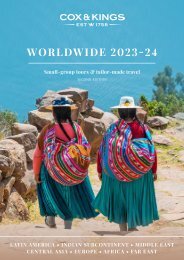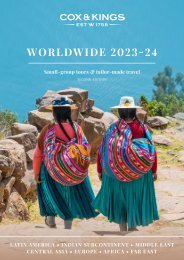WW23-24 Brochure updated for Yumpu
You also want an ePaper? Increase the reach of your titles
YUMPU automatically turns print PDFs into web optimized ePapers that Google loves.
Isalo National Park<br />
Deep canyons & magical waterfalls •<br />
Elephant’s foot bloom in September & October<br />
One of Madagascar's prettiest parks, Isalo<br />
encompasses a huge sandstone massif<br />
interspersed with canyons, tapia <strong>for</strong>est,<br />
waterfalls and natural springs. Wildlife<br />
densities may be lower than in other parks,<br />
but both ring-tailed and red-fronted lemurs<br />
are often seen. There are 80 bird species (50<br />
endemic) and more than 500 plant species –<br />
including elephant’s foot, whose austral-spring<br />
bloom creates a sea of yellow. The dry climate<br />
ensures suitable conditions <strong>for</strong> walking year<br />
round, and trails cater <strong>for</strong> all abilities.<br />
Isalo National Park<br />
Ranomafana National Park<br />
Beautiful montane rain<strong>for</strong>est • Home to rare<br />
golden bamboo & greater bamboo lemurs<br />
Ifotaka Community Forest<br />
Lemur spotting in rare gallery & spiny <strong>for</strong>est •<br />
Fascinating Antandroy tribal culture<br />
Golden bamboo lemur, Ranomafana National Park<br />
Established in 1991, Ranomafana has quickly<br />
become a popular destination <strong>for</strong> wildlife<br />
viewing on foot. Steep slopes and elevations<br />
ranging between 600 and 1,400m allow <strong>for</strong><br />
different <strong>for</strong>est types, from lowland to cloud.<br />
There are 12 lemur species in total here, the<br />
best known being the golden, greater and<br />
lesser eastern bamboo lemurs. Ranomafana<br />
is also noted <strong>for</strong> its 118 bird species, of which<br />
36 are endemic. Amongst them are Henst’s<br />
goshawks, rufous-headed ground-rollers,<br />
velvet asities and the crested ibis.<br />
The Ifotaka Community Forest is a reserve<br />
managed by the local Antandroy people.<br />
Wildlife activities range from spotting ringtailed<br />
lemurs and Verreaux’s sifakas in the<br />
deciduous gallery <strong>for</strong>ests, to searching <strong>for</strong><br />
white-footed sportive and mouse lemurs<br />
by night in the unique spiny <strong>for</strong>est. Cultural<br />
activities, focused on the Antandroy tribe, are<br />
exceptional. Spend a morning at the buzzing<br />
and authentic local market, or take a walk with<br />
an Antandroy guide into the sacred <strong>for</strong>ests to<br />
find huge, individually decorated tombs.<br />
Traditional Antandroy tribal tomb<br />
Kirindy Private Reserve<br />
Best place to see fossas • Home to Madame<br />
Berthe’s mouse lemurs<br />
Fossa<br />
Kirindy’s dry deciduous <strong>for</strong>est is home to some<br />
extraordinary wildlife, not least the elusive<br />
fossa, a nocturnal feline that is the only natural<br />
hunter of Madagascar’s lemurs. The best time<br />
to find them is at night during their mating<br />
season (October to December). Madame<br />
Berthe’s lemurs are one of eight lemur species<br />
that can be found in the park and are the<br />
smallest primates in the world. Giant jumping<br />
rats – kangaroo-like rodents – are another<br />
rarity. Kirindy is best visited between October<br />
and January when rain-quenched vegetation<br />
draws animals out of hibernation.<br />
For more in<strong>for</strong>mation or to book, contact us on 020 3930 5008 or speak to your travel agent<br />
183







